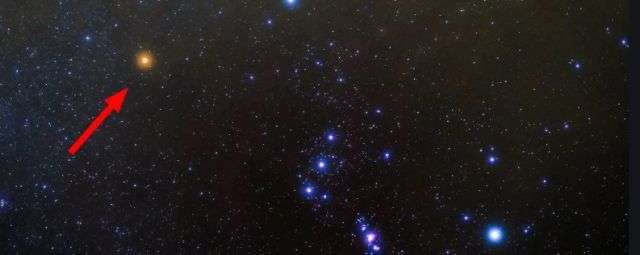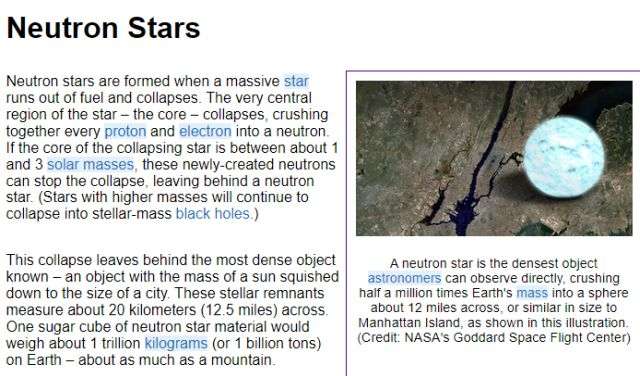
Betelgeuse, about 700 lightyears from our Sun in the Orion Constellation. It has near-infrared wavelenghts and a mass estimated to be between a little under ten, and twenty times the mass of the Sun.
And neutron stars are the collapsed cores of a giant stars. Before collapse such a giant star had a mass of between 10 and 29 times that of our Sun. Neutron stars are the smallest and densest stars, not counting the (still hypothetical) white holes, quark stars, and strange stars, and neither counting Black Holes of course. To make it clear, a neutron star is also certainly far smaller than a White Dwarf, which still has a volume akin to that of Earth. Indeed, neutron stars have a radius of approximately 10 kilometres (6.2 mi) and a mass of about 1.4 solar masses. They come into being as a massive star goes supernova, followed by with gravitational collapse, which compresses the core past white dwarf star density to that of atomic nuclei.

(via https://imagine.gsfc.nasa.gov/)
In 1975, physicist Kip Thorne (who recently was scientific adviser to Christopher Nolan when he was making Interstellar) and Polish astronomer Anna Zytkow proposed a new type of star, one which would originate by the merger of a red supergiant and a neutron star. These as yet hypothetical mergers became known as Thorne-Zytkow Objects (TZO's). Via Astronomy dot com:
"Nearly half a century ago, physicist Kip Thorne (now a Nobel laureate) and astronomer Anna Żytkow suggested a strange, Russian-nesting-doll-type star might be hiding in the cosmos, just waiting to be found by those who knew how to seek it. Astronomers named these theoretical stellar hybrids Thorne-Żytkow objects.
The possible existence of Thorne-Żytkow objects came to light when their namesake researchers ran early computer simulations. When they did, they found that a neutron star — a tiny, ultra-dense stellar remnant left behind when a star goes supernova — could be gobbled up by a red supergiant star.
According to the simulations, if the “Twins” (in the Danny DeVito-Arnold Schwarzenegger sense) get too close to one another, instead of one star getting ejected, the two stars can merge together. The city-sized, solar-mass neutron star would carry on living inside its much larger host, almost like a cosmic parasite.
In a study published in 1975 in The Astrophysical Journal, Thorne and Żytkow suggested these stars would look almost identical to red supergiants like Betelgeuse in the constellation Orion. Supergiant stars are relatively common and are some of the youngest and largest stars in the universe. Thorne-Żytkow objects (TZOs) would look very similar to red supergiants, but are suspected to survive up to 10 times longer.
Ordinary red supergiants, like other stars, are powered by nuclear fusion in their cores. So when that energy runs out, their uncontested gravity causes them to implode before erupting as a supernova. But TZOs can live such long lives because they do not rely on sustained nuclear fusion in their cores to avoid collapse. Instead, a TZO’s neutron star core, which is already extremely compressed, largely prevents the rapid and uncontested gravitational collapse of the surrounding supergiant layers.
Astronomers have two different theories for how TZOs form — and they both depend on the initial objects starting their lives as two gigantic stars in a close binary system. In one theory, the bigger of the two stars would explode as a supernova first, leaving behind a neutron star. But over time, the remaining supergiant would continue to balloon outward, growing until it fully swallowed the nearby neutron star remnant.
Another possibility for the formation of TZOs is that when one star explodes as an asymmetric supernova, its remnant core could get a powerful “kick.” That could potentially fire the neutron star into the belly of the remaining red giant..."
Check out this video:
So now you can go to sleep in the secure knowledge that you're a somewhat smarter person!
MFBB.